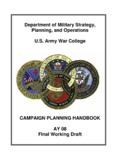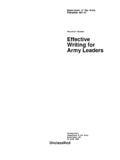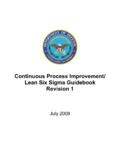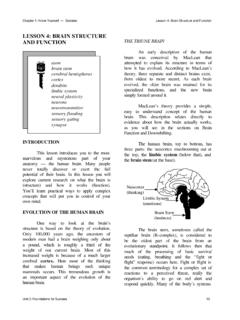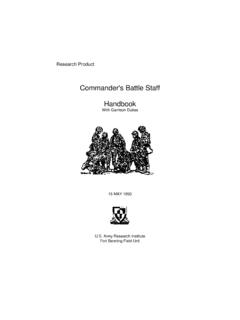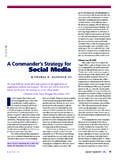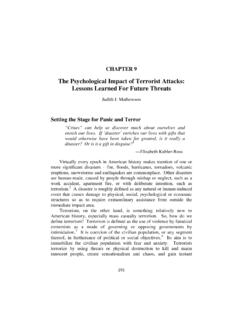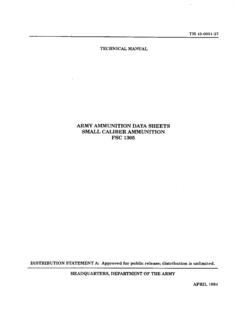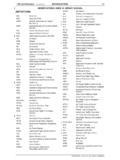Transcription of HICKS AND ASSOCIATES INC. Unified Vision 01 DART RED …
1 HICKS AND ASSOCIATES INC. & quot ; Unified Vision 01. DART DEFENSE ADAPTIVE. RED TEAM. WORKING. PAPER. #02-4. A Practical Guide December 2002 for Developing and Writing Military Concepts by John F. Schmitt POC: Dr. Jim Miller HICKS & ASSOCIATES , Inc. 1710 SAIC Drive, Suite 1300 DART Working Papers address critical issues McLean, VA 22101 associated with joint concepts, experimentation, DEFENSE ADAPTIVE RED TEAM. CONTRACT NOO140-01-D-H029 and red teaming best practices. Comments are welcome. DRAFT WORKING PAPER. DEFENSE ADAPTIVE RED TEAM. Preface The Defense Adaptive Red Team (DART) is a pilot project.
2 Its mission is to serve as an independent red team that challenges the joint community to develop more robust and resilient concepts for conducting joint operations, and to develop a code of best practices for red teaming. The DART is organized as a network; in its first year of operations, over fifty individuals have participated in concept analysis, experimentation, and studies of red teaming best While a captain on active duty, John F. Schmitt authored the Marine Corps' keystone doctrinal manuals Ground Combat Operations, Warfighting and Campaigning. He later authored the Marine Corps Doctrinal Publications Command and Control (MCDP 6), Planning (MCDP 5), and Expeditionary Operations (MCDP 3), as well as the revision of Warfighting (MCDP 1).
3 The author would like to acknowledge the following individuals for their assistance. LtGen. Paul K. Van Riper, USMC (Ret), was a partner in every aspect of the development of this paper, collaborating in its organization and structure, contributing to the formulation of ideas, and reviewing every draft. Dr. Jim Miller provided support and encouragement, as well as substantive input, at every stage of development. Gen. Anthony Zinni, USMC (Ret), provided important comments and recommendations on several drafts of the paper. LtCol. Matthew Lopez, USMC, provided significant insights and guidance, and championed the paper in the Joint Staff.
4 This paper benefited greatly from review at two workshops. Col. John Collins, USMC, Mr. Jeffrey Cooper, Dr. Williamson Murray, and COL Richard Hart Sinnreich, USA (Ret), all provided insightful comments and recommendations at the first workshop; their efforts improved the paper significantly. At the second workshop, Dr. Jim Blaker and COL Mike Starry, USA. (Ret), provided detailed and extremely helpful commentary on the second half of the paper. The following individuals also contributed to the paper through their active participation in the second workshop: Col. Gary Anderson, USMC (Ret); LTC Michael Coss, USA; Mr.
5 Shane Deichman; Col. Thomas Hammes, USMC; Maj. William Inserra, USMC; LtCol. Doug King, USMC; LTC Randal Lane, USA; LTC Ronald Miller, USA; Mr. Joe Purser; Mr. David Reeths;. CAPT John Sandoz, USN (Ret); Col. Fred Wenger, USMC; and LTC Kevin Woods, USA. 1. DART work is conducted under contract # GS-23F-8006H, Delivery Order #: DASW01-01-F-0984 for the Office of the Deputy Undersecretary of Defense for Advanced Systems and Concepts. The publication of this working paper does not indicate endorsement by the Department of Defense, nor should the contents be construed as reflecting the official position of that Agency.
6 HICKS AND ASSOCIATES , INC. WORKING PAPER. ii WORKING PAPER. DEFENSE ADAPTIVE RED TEAM. Contents 1. Part I. A Framework for Military 2. Military 3. Institutional Concepts ..6. 4. Operating 5. Functional 6. Enabling Concepts ..10. Part II. Assessing Future Operating 7. 8. Reasons for a New Operating 9. Foundations of a Good Future Operating Concept ..12. 10. Elements of Future Operating Concepts ..15. 11. Attributes of a Good Future Operating Concept ..19. 12. Epilogue: The Concept Development and Validation Annotated Glossary ..24. HICKS AND ASSOCIATES , INC. WORKING PAPER.
7 Iii WORKING PAPER. DEFENSE ADAPTIVE RED TEAM. 1. Introduction Purpose. The purpose of this paper is to provide a common framework and practical guidelines for developing and writing military operating concepts and for evaluating the validity and quality of those concepts, with the ultimate goal of encouraging the development of more thoughtful and useful concepts. Background. With the adoption of a concepts-based combat development process, so-called operational concepts have proliferated, to the point that an important and useful military term has been rendered practically meaningless.
8 This point was compellingly made in a recent article by Col. David A. Fastabend, That Elusive Operational Concept. 2 Some operational concepts are legitimately that; that is, they describe the conduct of military action at the operational level of war. Most, however, are not. The term operational concept has come to be applied loosely to any description of military (or even non-military) activity or capability. Consequently, descriptions of purely technical or procedural activities are promoted as operational concepts. As a result, the difference between high-order descriptions of military action and mere procedures can be lost, and the conduct of military action thereby risks being reduced to technique or procedure.
9 A standard web search uncovers operational concepts . numbering in the hundreds. To name only a few examples from such a search, approved or proposed military operational concepts exist for the following: Potable Water Support Enhanced Fiber Optic Guided Missile (EFOGM) Company Employment Air Defense Data Links Combat Health Support Air Force Electronic Publishing Night Vision Goggles Vertical Takeoff and Landing Tactical Unmanned Aerial Vehicle (VTUAV) Program Use of Army Bands in Combat Areas Combat Service Support Adding to the confusion, these types of concepts are sometimes also mistakenly referred to as concepts of operations, which term properly has a different meaning altogether.
10 Additionally, Joint Vision 2020 identifies dominant maneuver, precision engagement, focused logistics, and full dimensional protection as operational concepts. These, of course, are modified descriptions of the traditional battlefield functions of maneuver, fires, logistics, and security. These concepts would more properly comprise the main functional elements of a true operational concept. 2. Army, June 2001. HICKS AND ASSOCIATES , INC. WORKING PAPER. 1. WORKING PAPER. DEFENSE ADAPTIVE RED TEAM. Recommendations. This paper proposes to implement the following remedies, which will be adopted throughout the paper: Define the term operational concept narrowly to refer only to the application of military art and science at the operational level of war.
